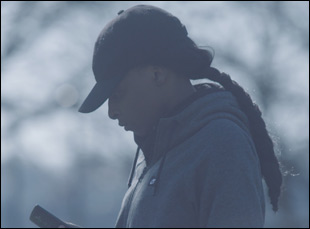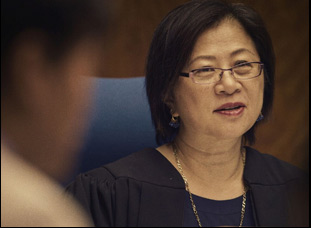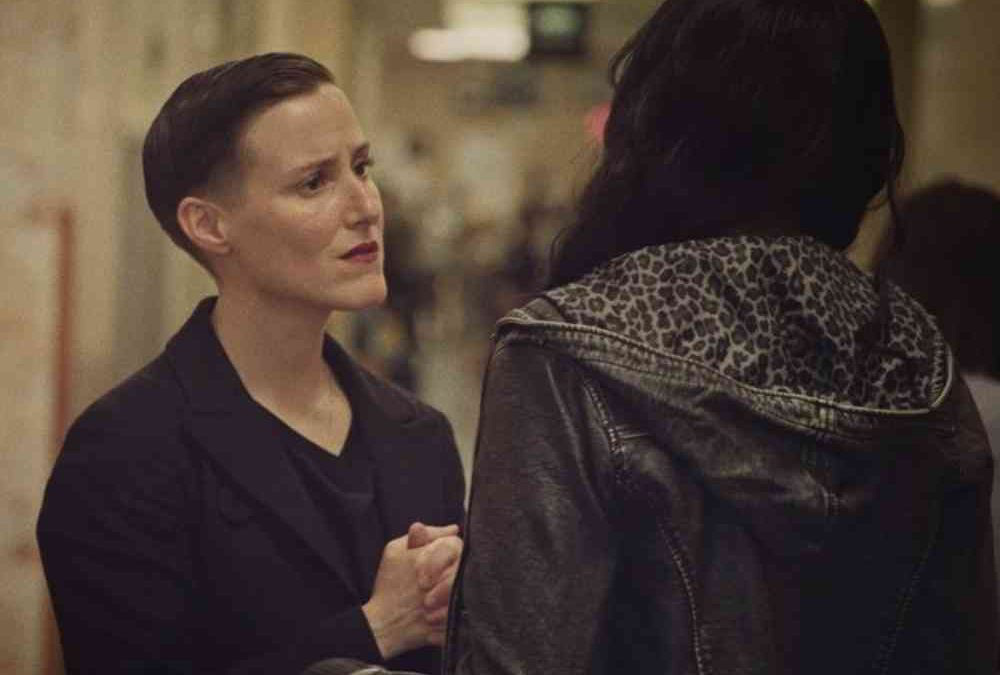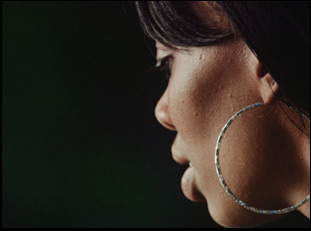For much of “Blowin’ Up,” you see Eliza Hook zipping around the hallways of the Queens Criminal Court in Kew Gardens, fearlessly thrusting herself into one interaction after another with women who don’t speak English and are often afraid to talk anyway, finding themselves at the trafficking and intervention court where they may have been brought by cops on prostitution charges but face a virtual prison even if they elude jail time since they’re opportunistic pimps have seized upon their precarious immigration status to lure them into sex work and prevent them from doing anything else. Hook, a social worker for GEMS (Girls Educational & Mentoring Services) in New York, isn’t an official member of the court, but in the unique way Judge Toko Serita has set up her courtroom, she’s an integral part, passionately and articulately speaking on behalf of the women who have few other advocates. Still, when it came to the premiere of “Blowin’ Up” at the Tribeca Film Festival earlier this year, Hook wasn’t much for socializing.
“She calls herself an introvert!” the film’s director Stephanie Wang-Breal exclaims playfully, bumping shoulders with Hook as they sit together in a booth, shortly following the film’s debut.
“My dream would be to have three days by myself without speaking to another human being, reading books and watching Netflix and eating popcorn the entire time,” says Hook, nudging Wang-Breal right back.
While watching “Blowin’ Up” you’re grateful that at least this dream of Hook’s might not come to pass, there are others that might seem impossible in regards to the women that she fights for that seem amazingly within reach, though it is only through the set-up that has been established in Queens where Judge Serita issues rulings that not only take into consideration the letter of the law, which has been abused by police to pad their stats and by pimps to have an additional threat at their fingertips, but of the complete social circumstances of those who stand accused, with both the prosecution and defense agreeing to take part in this more pragmatic approach that comes to include far more emphasis on rehabilitation. It isn’t just Judge Serita who takes in a full view of those who appear in her courtroom, but Wang Breal as well, building a portrait of quiet courage of the women who have only their inner strength to draw on as they fight charges in a legal system that typically has been so weighted against them, indicative of a larger societal indifference to their fate, as well as the women in positions of power who have used what clout they have to find compassionate resolutions.
Yet Wang-Breal and producing partner Carrie Weprin are careful not to let the women’s occupation define who they are, no matter which side of the law they are on, following Judge Serita to Sapporo, Japan where she tends to her parents or sensitively observing one of the former sex workers who’s looking to leave that life behind weeping in court as a recommendation letter on their behalf is read and you realize it’s the first time she may have heard a kind word said about her since she was a child, if ever. Not only have those in Queens built something truly special with the court, but the filmmakers of “Blowin’ Up” have done something equally impressive in giving it a well-deserved spotlight and capturing it in all its complexity and Wang-Breal and Hook share how it was made despite the odds being heavily stacked against it.
Stephanie Wang-Breal: I read an article in the New York Times in 2014 about this court, serving a population of women coming from the foster care system and also undocumented Asian immigrants, [both of which] I was deeply invested in because of my previous work. “Wo ai ni mommy” focused on a Chinese girl adopted by an American family and her immigration story into America and then my second film “Tough Love” was about the child welfare and foster care system. I always knew from making that film that the results of children who age out of the system are just terrible and that 85 percent of trafficked youth come from the foster care system in New York state. So I forwarded the article to Carrie [Weprin, my producing partner] and said, “Let’s hop on the F train and check out this place. And it’s run by a Japanese female judge. It’s a courtroom full of women!” But I don’t think anything could’ve prepared us for the kinds of women that actually populated this space when we walked inside. I looked at Eliza [Hook], Eliza looked at me — and she knew I wasn’t a defendant, but she was also just like, “Who are these hipster looking girls walking into this space?”
Eliza Hook: In Steven Alan shirts. [laughs]
Stephanie Wang-Breal: That you now have! But there was just this energy there — everyone was so different, but there was this cameraderie going on and I wondered if I could bring that energy to life in a film. Carrie and I also observed a Brooklyn court as well as a Manhattan court, but everything about the energy and the architecture of the space in Queens – the wood paneling, the light panels — [made us] keep coming back to this courtroom and talking to Eliza, Leigh Latimer [a Legal Aid Society lawyer], and Judge Serita just to figure out what was going on because we didn’t know anything.
You’ve said it took a year just to gain the trust of the participants in the court. Eliza, what was it like to give that?
Eliza Hook: I didn’t know if it was going to be a good thing until Saturday, April 21st. At the [Tribeca] premiere. I really didn’t know. Because of everything I had been through in my life in general and then in my career, there’s always going to be skepticism, regardless of how much I want to put my full trust in filmmakers, but I think that’s okay to do. I trusted them as much as I could probably trust anyone and it took you 10 months to mic me…
Stephanie Wang-Breal: And even that was reluctant. That wasn’t like, “Oh, yeah, go ahead.” She’d be like, “Hold on, maybe you can mic me later.”
Eliza Hook: And I’d also speak in the mic a lot and be like, “You can’t use that in the film.” So they have about 400 hours of footage, and about 200 of that is me telling them they can’t use it. [laughs] But it’s nothing short of a miracle what they’ve done. [Stephanie and Carrie are] spectacular human beings and I’m super fans of theirs, both as human beings in the world and as artists because there’s really an art to it. But it took me a long time and even through all the years [of filming], I still gave them trouble. Every single time they would ask me that they would want to put a camera on me, I was very calculated about that.
Stephanie Wang-Breal: Yeah, even [when we see Eliza in the] hair salon, it was like, “Why do you want to do that?” Well, we want to show your life outside [the court]. We don’t want to just show what’s happening in the courtroom.
Eliza Hook: And I’d be like, “This is not about me. It’s about the young women that I serve.”
Stephanie Wang-Breal: So every single scene in the film was another discussion about access. Just because we got access to the court doesn’t mean it was free-flowing from there. The free-flowing love is happening now. When [Eliza] saw the screening, she was like, “Thank God, I was so worried it was going to be so boring I was going to fall asleep in it. You actually made a film.” [laughs] And we’re like, “Yeah, we were serious.” (laughs) We were serious women.
Eliza Hook: I was just very protective of the young women I served, mainly. In fact, the two young women that are actually in the film, when they asked me my opinion of whether they should be in the film, I told them no and they decided to go forward and be in the film, but that was not based on my suggestion or my support of it. When they decided as their own human being to be in the film and I was like, “Well, I’ll be there to advocate for you in that process,” but I actually did not want either Dee or Candy to be in the film.

Eliza Hook: Access. That’s literally the only access that [the filmmakers] had. What you see in the film is the access they had regarding the people that we served because we were so insular and protective, for obvious reasons. When people are like, “Oh my gosh, I can’t believe the access that you had,” I want to correct them and say they literally had so little access that the film that they made is a miracle and all that much more genius and better because of it. There was 70 other things they could’ve covered that they did not have access to and yet they still managed to bring their vision to life.
Stephanie Wang-Breal: Susan [Liu of Garden of Hope, the women’s advocacy group who works with former sex workers] had taken a break from the court for a while and all the Asian counselors didn’t want to be filmed, because they didn’t want to be associated with this space, so we had very limited access to them. And once Susan came back, she was like, “I believe in you guys and I want to help.” But every time we’d talk about what that involves and [for Susan,] what does filming my undocumented clients actually mean?
The film is shot with both incredible sensitivity and very attuned to the emotional dynamics of the room. What was it like figuring out how to film this?
Stephanie Wang-Breal: I had two different shooting styles going on, one [was] for inside the courtroom where I wanted it to feel like it was a Robert Altman film, so I knew that I needed to have more than one camera. We actually had two for the first shoot, but I felt I didn’t have enough coverage, so I went to three because I needed to make sure we’re covering what’s going on in the front [of the court], what’s going on in the back and then what’s going on in the hallways because the hallways were where you really see the dynamics going on of all the different kinds of conversations happening and what these conversations reveal about this space and this procedural criminal justice process. You realize this is the first time some of these defendants are meeting their lawyers, and you’d think that they’ve met them before, but you don’t realize that until you hear those conversations. So in order to do that, we also had seven to eight channels of audio so we could jump in and out of conversations and capture these bits and pieces.
Then outside of the courtroom, I really wanted to shoot with a longer lens so that we weren’t in [Eliza’s] face or [the women we were following], while also shooting with more than one camera so that we could cover things and just give light to who these women are outside of this space — that they’re women. Some [are] girls, but they’re women figuring out life and everyday problems we all have, trying to get by. [Which was why it was important to also show] Eliza and Judge Serita outside [the court] — [Eliza’s] not just a counselor, but a woman with a girlfriend who she loves, and Judge Serita is not just a judge, but a wife, a caretaker of her mother and her father. So there were two different things going on in terms of how I shot each space.
One of the things I found so brilliant about the movie is how much exposition is conveyed in what seem like verite moments that just unfold – Judge Serita has that scene where she’s asking about law enforcement. Was it challenging to find such scenes that would do that heavy lifting or does that naturally happen from spending so much time there?
Stephanie Wang-Breal: In the editing room, my mandate for our whole team was how can we feel the work that they’re doing, not tell. Every scene that didn’t do that job [I said], let’s push it to the side. If we have to use it, we’ll use it, but let’s see all the footage that we have where we can just experience as it’s happening. So we were very lucky we were in the judge’s office when that phone call came in from the detective and she explained what she wanted to do and [that] “the law enforcement side is something I’m still trying to figure out.” She’s not involved in that side. She’s involved in this part [of the court], so she’s trying to figure it all out herself, even as a judge.

Eliza Hook: There’s so many things that are important to convey outside of the film. It’s complicated because the lives of these young women, what you don’t really get a sense is of the compounded trauma of what they’ve endured because we don’t really delve into every little detail that they’ve been through and their daily reality, which could consist of being murdered which has happened. The anniversary of one of my young women’s murder four years ago [is next week]. We couldn’t make a 27-hour film, but [Stephanie and Carrie] did an amazing job doing what you could with the access that we gave you.
Stephanie Wang-Breal: I also think one thing that isn’t necessarily portrayed in the film, but we tried to do with the way we built the scenes and the moments throughout the film is questioning should this court exist? What is the implications of this court’s existence overall? I really hope that people come away with different feelings about that because [the court] is a great place if we look at the humanity behind it, but does it need to exist?
Eliza Hook: It’s the best/worst in a puritanical law system. None of us wanted to be there. We would all love to be put out of a job for that reason. We believe in decriminalization. There’s a lot of people who have their agendas who oppose that court because they have made up their minds about what it is without actually witnessing what it is. We know there is a difference between trafficking and agency to make the decision to be a sex worker. Those are two very different conversations and there’s a lot of people that are trying to make those the same conversation. But we’re talking about individual people’s lives, and you can not make blanket statements or assumptions about any single person that you come across.
I also wish the film also conveyed what the legal definition of trafficking is – how a girl from East New York can be taken to the Bronx and that’s actually trafficking. You think how long it takes to get from East New York to the Bronx? That’s going to a different state essentially in the rest of the country. [And the sex traffickers] take someone’s phone, their ID, their means of contacting family – they know nobody in the neighborhood, and there’s five people watching them when they leave that’ll call their exploiter if they’re going anywhere other than the bodega. They can’t get on social media. The only reason I’m telling you this is because I can imagine as my friends have told me who have seen the film, “I had questions going in and I had even more questions [after],” so if I can provide any answers to any of those questions that people have in the end, that’s what I’m doing.
“Blowin’ Up” will open in New York on April 5th at the Quad Cinema and April 12th in Los Angeles at the Laemmle Music Hall.





